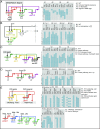Assessing regulatory information in developmental gene regulatory networks
- PMID: 28584110
- PMCID: PMC5468647
- DOI: 10.1073/pnas.1610616114
Assessing regulatory information in developmental gene regulatory networks
Abstract
Gene regulatory networks (GRNs) provide a transformation function between the static genomic sequence and the primary spatial specification processes operating development. The regulatory information encompassed in developmental GRNs thus goes far beyond the control of individual genes. We here address regulatory information at different levels of network organization, from single node to subcircuit to large-scale GRNs and discuss how regulatory design features such as network architecture, hierarchical organization, and cis-regulatory logic contribute to the developmental function of network circuits. Using specific subcircuits from the sea urchin endomesoderm GRN, for which both circuit design and biological function have been described, we evaluate by Boolean modeling and in silico perturbations the import of given circuit features on developmental function. The examples include subcircuits encoding positive feedback, mutual repression, and coherent feedforward, as well as signaling interaction circuitry. Within the hierarchy of the endomesoderm GRN, these subcircuits are organized in an intertwined and overlapping manner. Thus, we begin to see how regulatory information encoded at individual nodes is integrated at all levels of network organization to control developmental process.
Keywords: Boolean modeling; circuit function; developmental GRN; network hierarchy; network topology.
Conflict of interest statement
The authors declare no conflict of interest.
Figures



Similar articles
-
The function of architecture and logic in developmental gene regulatory networks.Curr Top Dev Biol. 2020;139:267-295. doi: 10.1016/bs.ctdb.2020.04.001. Epub 2020 May 19. Curr Top Dev Biol. 2020. PMID: 32450963
-
Conserved regulatory state expression controlled by divergent developmental gene regulatory networks in echinoids.Development. 2018 Dec 18;145(24):dev167288. doi: 10.1242/dev.167288. Development. 2018. PMID: 30470703 Free PMC article.
-
Methods for the experimental and computational analysis of gene regulatory networks in sea urchins.Methods Cell Biol. 2019;151:89-113. doi: 10.1016/bs.mcb.2018.10.003. Epub 2018 Dec 11. Methods Cell Biol. 2019. PMID: 30948033 Review.
-
A gene regulatory network subcircuit drives a dynamic pattern of gene expression.Science. 2007 Nov 2;318(5851):794-7. doi: 10.1126/science.1146524. Science. 2007. PMID: 17975065
-
Modularity and design principles in the sea urchin embryo gene regulatory network.FEBS Lett. 2009 Dec 17;583(24):3948-58. doi: 10.1016/j.febslet.2009.11.060. FEBS Lett. 2009. PMID: 19932099 Free PMC article. Review.
Cited by
-
Decoding the IGF1 signaling gene regulatory network behind alveologenesis from a mouse model of bronchopulmonary dysplasia.Elife. 2022 Oct 10;11:e77522. doi: 10.7554/eLife.77522. Elife. 2022. PMID: 36214448 Free PMC article.
-
Three topological features of regulatory networks control life-essential and specialized subsystems.Sci Rep. 2021 Dec 20;11(1):24209. doi: 10.1038/s41598-021-03625-w. Sci Rep. 2021. PMID: 34930908 Free PMC article.
-
Expression Profile of Genes Related to the Th17 Pathway in Macrophages Infected by Leishmania major and Leishmania amazonensis: The Use of Gene Regulatory Networks in Modeling This Pathway.Front Cell Infect Microbiol. 2022 Jun 14;12:826523. doi: 10.3389/fcimb.2022.826523. eCollection 2022. Front Cell Infect Microbiol. 2022. PMID: 35774406 Free PMC article.
-
A regulatory sub-circuit downstream of Wnt signaling controls developmental transitions in neural crest formation.PLoS Genet. 2021 Jan 19;17(1):e1009296. doi: 10.1371/journal.pgen.1009296. eCollection 2021 Jan. PLoS Genet. 2021. PMID: 33465092 Free PMC article.
-
What's next for computational systems biology?Front Syst Biol. 2023 Sep 19;3:1250228. doi: 10.3389/fsysb.2023.1250228. eCollection 2023. Front Syst Biol. 2023. PMID: 40809471 Free PMC article. Review.
References
-
- Peter IS, Davidson EH. Genomic Control Process, Development and Evolution. Academic/Elsevier; London: 2015.
-
- Davidson EH, et al. A genomic regulatory network for development. Science. 2002;295(5560):1669–1678. - PubMed
-
- Alon U. Network motifs: Theory and experimental approaches. Nat Rev Genet. 2007;8(6):450–461. - PubMed
Publication types
MeSH terms
LinkOut - more resources
Full Text Sources
Other Literature Sources
Miscellaneous

